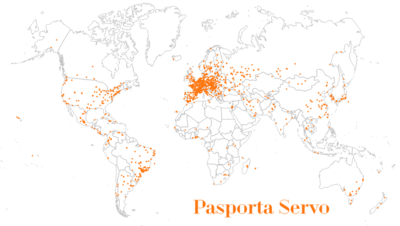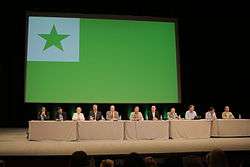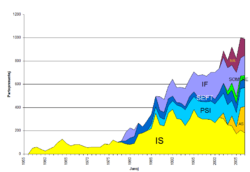Esperantujo
| Esperantujo | |||
|---|---|---|---|
| Linguistic area | |||
| |||
| Etymology: Esperant + ujo (“place of Esperanto”) | |||
|
Anthem: "La Espero" | |||
 Countries where a national Esperanto Association exists | |||
| Population | |||
| • Estimate (1999) | 2 million | ||
| Demonym(s) | Esperantist | ||
| Language | Esperanto | ||
|
Culture and media |
|
Related topics |
|
Wikimedia Portal · Task force Esperanto Wikipedia (Vikipedio) Vikivortaro · Vikicitaro · Vikifontaro Vikilibroj · Vikikomunejo Vikispecoj · Vikinovaĵoj |
Esperantujo (IPA: [es.pe.ran.ˈtu.jo]) or Esperantio [es.pe.ran.ˈti.o] (meaning "Esperanto-land") is the community of speakers of the constructed international auxiliary language Esperanto and their culture, as well the places and institutions where the language is used, referred to as if it were a country. Although it does not occupy its own area of Earth's surface, it can be said to constitute the 120 countries which have their own national Esperanto Association.
Etymology and terminology
The word is formed analogously to country names. In Esperanto, the names of countries were traditionally formed from the ethnic name of their inhabitants plus the suffix -ujo, for example "France" was Francujo, from franco (a Frenchman).
The term analogous to Francujo would be Esperantistujo (Esperantist-land). However, that would convey the idea of the physical body of people, whereas using the name of the language as the basis of the word gives it the more abstract connotation of a cultural sphere.
Currently, names of nation states are often formed with the suffix -io traditionally reserved for deriving country names from geographic features, so now Francio, and recently the form Esperantio has been used i.a. in the Pasporta Servo and the Esperanto Citizens' Community.
History
In 1908, Doctor William Molly attempted to create an Esperanto nation in Neutral Moresnet known as "Amikejo" (place of friendship). What became of it is unclear, and Neutral Moresnet was annexed to Belgium in the Treaty of Versailles, 1919.[1]
During the 1960s came a new effort of creating an Esperanto state, which this time was called Republic of Rose Island. The state island stood in Adriatic Sea near Italy.
After World War II, during Esperanto events there was a common currency used, but the management has stopped at the end of the 20th century.
In Europe on the 2nd of June 2001 a number of organizations (they prefer to call themselves establishments) founded the Esperanta Civito, which "aims to be a subject of international law" and "aims to consolidate the relations between the Esperantists who feel themselves belonging to the diaspora language group which does not belonge to any country". Esperanto Civito always uses the name Esperantujo (introduced by Hector Hodler in 1908), which itself is defined according to their interpretation of raumism, and the meaning therefore may differ from the traditional Esperanto understanding of the word Esperantujo.
In April 2007 there was an Esperanto Republic founded as a joke.
Geography

Esperantujo means any physical place as Esperanto meetings or virtual networks where they meet Esperanto speakers. Sometimes it is said that it is everywhere, where Esperanto together yet.
There is a German city, Herzberg am Harz, which since the 12th of July 2006 is called "the Esperanto city".[2] There are bilingual signs and pointers, in both German and Esperanto.
There have been attempts to indicate on a world map the places where Esperanto-speakers live. One of these most recent attempts is the website Esperantujo.directory. Judging by the members of the World Esperanto Association, here are the countries where there are most of Esperanto speakers:[3] Brazil, Germany, Japan, France, the United States, China, Italy.
Politics
Associations

There is no governmental system in Esperantujo because it is not a true state. However, there is a social hierarchy of associations:
- Universal Esperanto Association (UEA) is the principal association created in 1908, its central office is located in Rotterdam. The aim of the UEA is to promote the use of Esperanto, to strive for the solution of the language problem in international relations, to encourage all types of spiritual and material relations among people and to nurture among its members a strong sense of solidarity, and to develop in them understanding and respect for other peoples.
- Sometimes exist associations by continent, for example the European Esperanto Union.
- In at least 120 countries in the world exist national associations: Brazilian Esperanto League, the German Esperanto Association, Japanese Esperanto Association, Esperanto-USA and Australian Esperanto Association are examples from all continents across the world. The goals are usually to help teach the language and use of Esperanto in the country.
- Finally exist local associations or Esperanto clubs, where volunteers or activists offer courses to learn the language or get to know more about culture of Esperanto. Sometimes they teach Esperanto in universities or schools.
Also there are thematic associations worldwide, which are concerned with spirituality, hobbies, science or that brings together Esperantists which share common interests.
There is also a number of global organizations, such as Sennacieca Asocio Tutmonda (SAT), or the World Esperanto Youth Organization (TEJO), which has 46 national sections.
Foreign relations
Universal Esperanto Association is not a governmental system, however, the Association represents Esperanto worldwide. In addition to the United Nations and UNESCO,[4] the UEA has consultative relationships with UNICEF and the Council of Europe[5] and general cooperative relations with the Organization of American States. UEA officially collaborate with the International Organization for Standardization (ISO) by means of an active connection to the ISO Committee on terminology (ISO/TC 37). The Association is active for information on the European Union and other interstate and international organizations and conferences. UEA is a member of European Language Council, a joint forum of universities and linguistic associations to promote the knowledge of languages and cultures within and outside the European Union. Moreover, on 10 May 2011, the UEA and the International Information Center for Terminology (Infoterm) signed an Agreement on Cooperation, its objectives are inter exchange information, support each other and help out for projects, meetings, publications in the field of terminology and by which the UEA become Associate Member of Infoterm.
Political movement
In 2003 there was a European political movement called Europe–Democracy–Esperanto created. Within it is found a European federation that brings together local associations whose statutes depends on the countries. Working language of the movement is Esperanto. The goal is "to provide the European Union with the necessary tools to set up member rights democracy". The international language is a tool to enable cross-border political and social dialogue and actively contribute to peace and understanding between peoples. The original idea in the first ballot was mainly to spread the existence and the use of Esperanto to the general public. However, in France has grown steadily voices: 25067 (2004) 28944 (2009) and 33115 (2014). In this country there is a number of movements which support the issue: France Équité, Europe-Liberté, and Politicat.
Symbols

The Esperanto-flag is called Verda Flago (Green Flag). It consists of:
- a green towel with a ratio 2:3, where the green colour symbolizes hope. It is not clear that it used to be an "official" color, but the color 009900 is the most common.
- in the upper left corner there is a white square, where the white colour symbolizes peace and neutrality
- green five-pointed star known as Verda Stelo (Green Star), which symbolizes the five continents.
The anthem is called "La Espero" since 1891: it is a poem written by L. L. Zamenhof. The song is usually sung at the triumphal march composed by Félicien Menu de Ménil in 1909.
The Jubilee symbol represents the language internally, while the flag represents Esperanto movement. It contains the Latin letter E (Esperanto) and the Cyrillic letter Э (Эсперанто) symbolizing the unification of West and East.
In addition, Ludwik Lejzer Zamenhof, the initiator of the language, is often used as a symbol. Sometimes he is even called "Uncle Zam", referring to the cartoon incarnation of American Uncle Sam.
Population
Education
In addition to textbooks, including the Fundamento de Esperanto by Zamenhof, the Assimil-methods and the video-methods such as Muzzy in Gondoland of the BBC and Pasporto al la tuta mondo, there are many courses for learning online. The local clubs and intensive internships are also very frequent and wealthy executives in the regions where they are active Esperanto association. Moreover, some universities teach Esperanto, and the Higher Foreign Language training (University Eötvös Loránd) delivers certificates in accordance with the Common European Framework of Reference for Languages (CEFR).[5] More than 1600 people have such a certificate around the world: in 2014 around 470 at the level of B1, 510 at the level of B2 and 700 for C1.[6] The International League of Esperanto Teachers (ILEI) is also working to publish learning materials for teachers.
The University of Esperanto offers video lectures in Esperanto, for specialties like Confronting War, Informational Technologies and Astronomy. Courses are also held during the World Esperanto Congress in the framework of the Internacia Kongresa Universitato (IKU). After that, UEA uploads the related documents on its website.[7]
Science is an appropriate department for works in Esperanto. For example, the Conference on the Application of Esperanto in Science and Technology (KAEST) occurs in November every year since 1998 in the Czech Republic and Slovakia. Personal initiatives are also common: Doctor of mathematics Ulrich Matthias created a document about the foundations of Linear Algebra[8] and the American group of Maine (USA) wrote a guidebook to learn the programming language Python.[9]
In general, Esperanto is used as a lingua franca in some websites aiming teaching of other languages, such as German,[10] Slovak,[11] Swahili,[12] Wolof[13] or Toki Pona.[14]
Media
Since 1889 when La Esperantisto appeared, and soon other magazines in Esperanto throughout many countries in the world. Some of them are information media of Esperanto associations (Esperanto, Sennaciulo and Kontakto). Online Esperanto magazines like Libera Folio, launched in 2003, offer independent view of the Esperanto movement, aiming to soberly and critically shed light on current development. Most of the magazines deal with current events; one of such magazines is Monato , which is read in more than 60 countries. Its articles are written by correspondents from 40 countries, which know the local situation very well.[15] Other most popular[16][17] Esperanto newspapers are La Ondo de Esperanto, Beletra Almanako, Literatura Foiro, and Heroldo de Esperanto. Often national associations magazines are also published in order to inform about the movement in the country, such as Le Monde de l'espéranto of Espéranto-France. There are also scientific journals, such as Scienca Revuo of Internacia Scienca Asocio Esperantista (ISAE).
Muzaiko is a radio that is emitted since 2011 all-day international program in Esperanto, songs, interviews and current events. The last two you can download to listen to them later as podcasts.[18] Besides Muzaiko, the other rays offer only an hour when Esperanto is the working language: Radio Libertaire, Polskie Radio, Vatican Radio, Varsovia Vento, Radio Verda and Kern.punkto.
EsperantoTV is an IPTV created in 2014 that emits news, musical videos, interviews in Esperanto. It is also accessible by Roku-system on domestic television.
Internet
Spread of the Internet has enabled more efficient communication among Esperanto speakers and slightly replaced slower media such as mail. Many massively used websites such as Facebook or Google offer Esperanto interface.[19][20] On 15 December 2009, on the occasion of the jubilee of 150th birthday of L. L. Zamenhof, Google additionally made visible the Esperanto flag as a part of their Google Doodles.[21] Media as Twitter, Telegram, Reddit or Ipernity also contain a significant amount of people in this community. In addition, content-providers such as WordPress and YouTube also enable bloggers write in Esperanto. Esperanto versions of programs such as the office suite LibreOffice and Mozilla Firefox browser, or the educational program about programming Scratch are also available. Additionally, online games like Minecraft offer complete Esperanto interface.
Sport
Although Esperanto is not a country, there is a Esperanto football team, which has existed since 2014 and participates in matches during World Esperanto Congresses.[22] The team is part of the N.F.-Board and not of FIFA, and have played against the teams of Armenian-originating Argentine Community in 2014 and the team from Western Sahara in 2015.
Esperanto speakers and Esperantists
Initially, Esperanto speakers learned the language as it was described by L. L. Zamenhof.[23] In 1905 the Fundamento de Esperanto put together the first Esperanto textbook, an exercise book and a universal dictionary.[24]
The "Declaration about the essence of Esperantism" (1905) defines an "Esperantisto" to be anyone who speaks and uses Esperanto.[25] "Esperantism" was defined to be a movement to promote the widespread use of Esperanto as a supplement to natural languages in international and inter-ethnic contexts. As the word "esperantist" is linked with this "esperantism" (the Esperanto movement) and as -ists and -isms are linked with ideologies, today many people who speak Esperanto prefer to be called "Esperanto speaker".
The monthly magazine La Ondo de Esperanto every year since 1998 proclaims an 'Esperantist of the year', who remarkably contributed to the spreading of the language during the year.
Economy
Businesses
Publishing and selling books, the so-called book services, is the main market and is often the first expenditure of many Esperanto associations. Some companies are already well known: for example Vinilkosmo, which publishes and makes popular Esperanto music since 1990. Then there are initiatives such as the job-seeking website Eklaboru, created by Chuck Smith, for job offers and candidates within Esperanto associations or Esperanto meetings.
Currency
Historically, the currency star was created in 1942 and has been used at meetings of the Universala Ligo and in Esperanto environments. Over the years it slowly became unusable and at the official closing of the Universala Ligo in the 1990s, the remaining star-coins were handed over to the UEA. You can buy them at the UEA's book service as souvenirs.
The current stars are made of plastic, they are used in a number of meetings, especially among young people. The currency is maintained by constellation, which calculates the rates, keeps the stock, and opened branches in various e-meetings. Currently there are stars of 1 ★ 3 ★ and 10 ★. Quotes of Stars at the 31 st December 2014 were [25] 1 EUR = 4.189 ★.[26]
Culture
Architectural heritage
There exist Zamenhof-Esperanto objects (ZEOs), scattered in numerous countries around the world, which are sort of the things named in honor of L. L. Zamenhof or Esperanto: monuments, street names, places and so on. There also exists UEA-committee for ZEOs.[27]
In addition, in several countries there are also sites dedicated to Esperanto: meetup places, whorkshops, seminars, fests, Esperanto houses. These places play the role of attractions for Esperantists. Here are two: the Castle of Grésilion in France and the Department of Planned Languages and Esperanto Museum in Vienna (Austria).
Cultural heritage
Esperanto literature heritage is the richest and the most diverse among literature in other constructed languages. There are over 25,000 Esperanto books (originals and translations) as well as over a hundred regularly distributed Esperanto magazines.
There is also a number of movies, which have been published in Esperanto. Moreover, Esperanto itself was used in numerous movies.
Celebrations
Many public holidays recognized by Esperanto speakers are celebrated international and already accepted in other countries and organizations such as UN or UNESCO. Here are the celebrations internationally proposed by the UEA since 2010:
| Date | Name | Meaning, purpose, anniversary |
|---|---|---|
| February 21 | International Mother Language Day | Save the cultural diversity and multilingualism |
| last full week of February | Week of International Friendship | Strengthen mutual contacts and sense. |
| April 14 | Memorial Day of all Pioneers | Anniversary of the death of L. L. Zamenhof (1917). |
| July 27 | Esperanto-day | Anniversary of the appearance of Unua Libro (1887). |
| September 21 | International Day of Peace (UN) | Not to fight, to stop wars and bring peace |
| September 26 | European Day of Languages (Council of Europe) | Inspire the learning of languages across Europe. |
| December 15 | Zamenhof Day | Birthday of L. L. Zamenhof (1859). Usual trade of Esperanto-books. |
Cultural events

Every year numerous meetings of Esperanto speakers in different topics around the world take place. They mobilize Esperanto-speakers which share the same will about a specific topic. The main example is the Universal Congress of Esperanto (UK), which annually organizes the UEA every summer for a week. Other events:
- SAT-Kongreso, annually organised by Sennacieca Asocio Tutmonda;
- International Youth Congress of Esperanto (IJK), official annual congress of TEJO;
- Internacia Infana Kongreseto (IIK), arrangement for children between 6 and 16 years that occur simultaneously with and close to the Universal Congress of Esperanto;
- Somera Esperanto-Studado (SES), the largest international Esperanto meeting aimed at learning of Esperanto.
Next to these globally comprising meetings there are also local events such as New Year's Gathering (NR) or Esperanto Youth Week (JES), which occur during the last days of December and first days of January. These meetings seem to be successful during the 20 last years.
Due to the fact that there are a lot of Esperanto meetings around the globe, there are two websites which aim to list and share them.Eventoj.hu describes them with a list and dates, and contains an archive until 1996, while Esperant.io offers world map with the locations of future meetings.
References
- ↑ http://www.moresnet.nl/english/geschiedenis_en.htm#Dr.%20Wilhelm%20Molly
- ↑ Retejo de Hercbergo
- ↑ Jarlibro de UEA, p. 248-249. Rotterdam, the Netherlands, 2016. ISSN 0075-3491.
- ↑ Pagxo pri UEA en la retejo de Unesko
- 1 2 Esperanto aperas en la KER-listo ene de la retejo de Konsilio de Euxropo
- ↑ Statistikoj pri la atestiloj de KER-ekzamenoj en Edukado.net
- ↑ Kursoj de Internacia Kongresa Universitato
- ↑ Fundamentoj de lineara algebro, Ulrich Matthias
- ↑ Instruilo por la programlingvo Pitono
- ↑ Deutsch.info instruas la germanan per Esperanto
- ↑ Slovake.eu instruas la slovakan per Esperanto
- ↑ Svahila kurseto cxe Jutubo
- ↑ PDF-a enkonduko al la lingvo volofa
- ↑ Tokipona.info instruas Tokiponon per Esperanto
- ↑ Kolofono de Monato
- ↑ Vocxdonado pri la plej popularaj Esperanto-gazetoj
- ↑ “Legado de esperantaj gazetoj”, en UEA en konscio de Esperantistoj, p. 39-41
- ↑ Listo de la programoj de Muzaiko.info
- ↑ Traduku Fejsbukon
- ↑ Guglo en Esperanto
- ↑ “Google festas la Zamenhof-tagon”, artikolo el Libera Folio
- ↑ (Esperanto) Intervjuo de Osmo Buller (Gxenerala Direktoro de UEA) pri la futbalmatcxo dum la 99a UK
- ↑ The book Lingvaj respondoj de Ludoviko (Eldonejo Ludovikito, 1990, 7-a eld.) contains about 120 pages of answers of Zamenhof to questions of Esperanto learners between 1887 and 1912.
- ↑ The speech of Zamenhof during the 8th Universala Kongreso de Esperanto in Krakovo (1912)shows that he does not want to take part in the language community as the “Majstro”.
- ↑ UEA en konscio de Esperantistoj, Zbigniew Galor and Jukka Pietiläinen, Kava-Pech, 2015, p. 14
- ↑ Kurzoj
- ↑ “Zamenhof/Esperanto-objektoj (ZEO-j)” en la retejo de UEA

